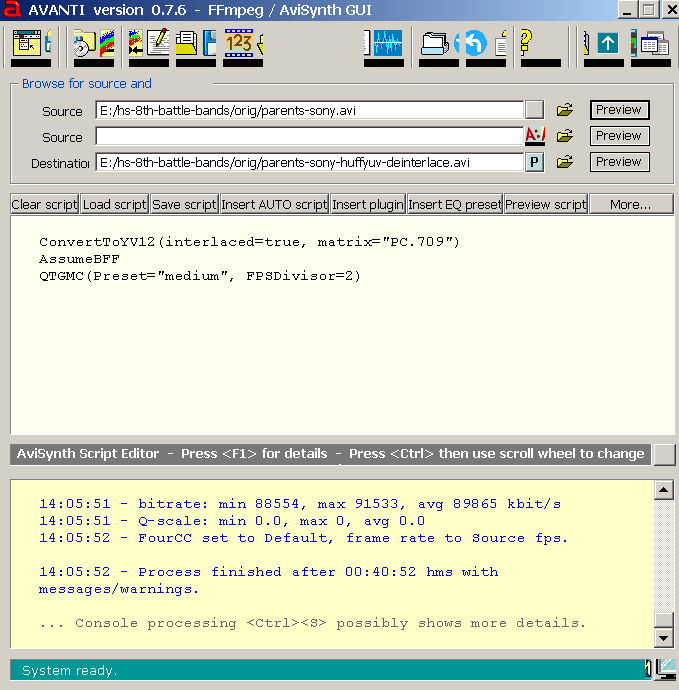
W3fdif is alright, but it's very simple (surprisingly so, considering the result isn't bad).
#Yadif avisynth full
Many don't follow these rules themselves and will use the full frame, in which case you don't want to mess around and can just do a simple scale to 1024x576. Check the clips that are recorded by the capture device first though, making sure there are small black bars on the left and right sides. I only mentioned 1024x576 for simplicity's sake, as I'm very aware this can get very complicated for a lot of people, but if you want to be technically accurate you should absolutely follow Noggin's advice. Noggin is also absolutely right (as he always is) that you should go with 1050x576, or crop to 702x576 and scale to 1024x576. I think YouTube understands the flags and handles them correctly, but I wouldn't rely on it. For everything I've recorded/digitised, I keep it as 720x576 flagged as 16:9, which plays back just fine in VLC, but for anything I've uploaded I've scaled it to 1024x576 first so that I can guarrantee it plays as 16:9 rather than as square pixels. That's the correct way to do it, but many applications don't support this as well as they should, so as Noggin said it's usually better to go with 1024x576. I thought you had to save it with 720x576 with a 16:9 flag on it. Don't try to scale in the interlaced domain - or worse treat interlaced content as progressive when you scale. And if you are scaling interlaced content - whatever you do make sure you deinterlace to 2x progressive, scale, and then re-interlace. (same reason we have black at 16 and not 0/1, and white at 235 not 254/5) If you are converting between SD and HD : HD->SD Scale 1920x1080 or 1280x720 to 702x576 and put 9 samples of black either side (or 704 + 8 if you have to) SD->HD Crop 720x576 to 702x576 and scale the 702x576 to 1920x1080 or 1280x720. They are there to avoid cropping overshoots/undershoots etc. There are 9 samples either side of the 702x576 that make 720x576 slightly wider. Golden rule with aspect ratios : 4:3 and 16:9 SD 50Hz are 702 x 576 NOT 720 x 576. It's trivial to convert SD MPEG2 with incorrectly flagged ratios to a nice square pixel progressive version with a YADIF or W3FDIF 2x deinterlace and scale. FFMPEG has a bit of a steep learning curve - but is well worth mastering. In this case a deirterlace from i25 to p50 may also be a good idea.
#Yadif avisynth Pc
If you are exporting for viewing on a PC or uploading to a social media or streaming site you may be better scaling 720x576 to 1050x576 (not 1024) or cropping to 702x576 and scaling to 1024x576. If you are exporting for DVD or captured at 720x576 then keeping it as 720x576 (avoiding a rescale) and ensuring that it is encoded with a non-square PAR (Pixel Aspect Ratio) is a good idea IF your player and encoding workflow flags it correctly.

If output is 50fps then it's ok.I thought you had to save it with 720x576 with a 16:9 flag on it. Also watch EVR output to see if u're not getting it deinterlaced twice, this problem can happen sometimes on some settings.

#Yadif avisynth software
Regarding deinterlace software u can also try the LAV filters, and quickly activate/deactivate between software (yadif 2x) or hardware and see the differences. For movies result was interesting, might be better than yadif 2x but for sports, like football, It created too much artifacts around the ball and small players so I didn't found it worth, despite of a globally better feeling of smoothness. For the typical 50i source, using yadif 2x u will get 50p so SVP will only calculate 10 additional fps if refresh rate is 60Hz and result can be strange, so advice is not using SVP in that conditionĪlso, I tested deinterlace algos for output of only 25p and used SVP to interpolate to 60fps. From experience for interlaced material the best is using only yadif 2x or bob without SVP, unless u have a 120Hz LCD, projector, or CRT capable of 90Hz and above.


 0 kommentar(er)
0 kommentar(er)
